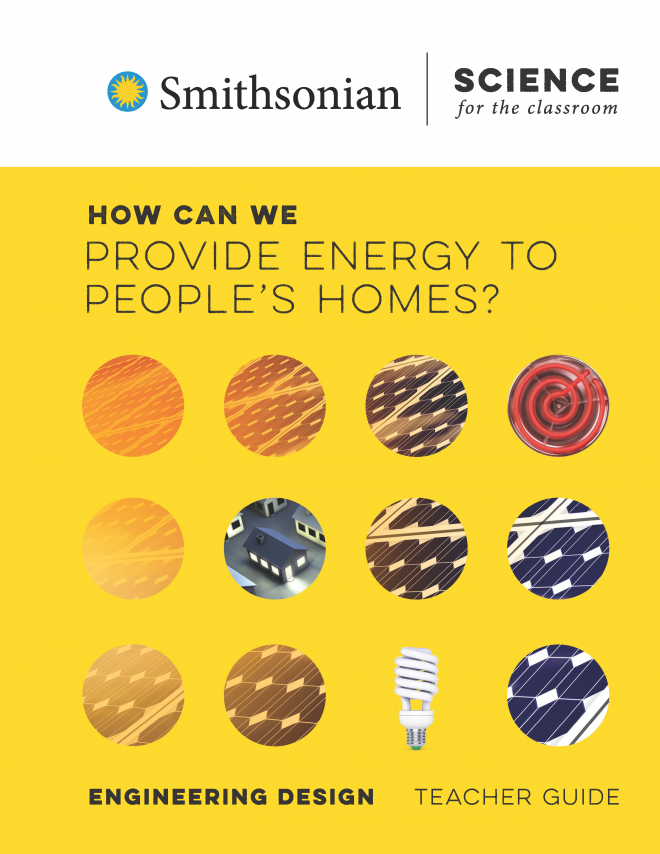How Can We Provide Energy to People’s Homes?
How Can We Provide Energy to People’s Homes?
How Can We Provide Energy to People’s Homes? is part of Smithsonian Science for the Classroom, a new curriculum series by the Smithsonian Science Education Center. It is aligned to a group of grade 4 standards. It has a focus on engineering with a secondary focus on physical science. In this module, students:
- Observe evidence of energy in systems and explore how that energy moves and changes
- Research how people obtain sources of energy for practical purposes
- Explain that some sources of energy affect the environment more than others
- Investigate how their designs affect the success of a student-built device
- Use their understanding of science and engineering to design and test a model house doorbell system that runs on solar energy
Below are digital resources that support teaching of this module.
Energy in the Kitchen
This file contains an illustration of a kitchen, where evidence of energy can be found.
Download the Energy in the Kitchen PDF
Black Marble
This file contains a NASA composite image that shows nighttime around the world.
Download the Black Marble PDF
NASA’s Earth at Night
This website provides articles and image resources teachers might find useful in guiding the class discussion about the Black Marble image.
https://earthobservatory.nasa.gov/Features/NightLights/
TED: William Kamkwamba: How I Harnessed the Wind
This video is a TED Talk by William Kamkwamba, who built a wind turbine for his home in Malawi, Africa, when he was 14 years old.
https://www.ted.com/talks/william_kamkwamba_how_i_harnessed_the_wind?language=en
CNN: Malawian Boy Uses Wind to Power Hope, Electrify Village
This website contains an article about William Kamkwamba and how he built a wind turbine for his home in Malawi, Africa, when he was 14 years old.
http://www.cnn.com/2009/WORLD/africa/10/05/malawi.wind.boy/index.html
Research Questions
Teachers can use this file to start a list of topics to guide their energy resource research.
Download the Editable Text File
Suggested Media Resources: These are some suggested resources to find information about different energy sources and to identify advantages and disadvantages of using the sources for electricity generation.
US Energy Information Administration Energy Kids, Energy Sources
http://www.eia.gov/kids/energy.cfm?page=2
US Nuclear Regulatory Commission What is Nuclear Energy?
https://www.nrc.gov/reading-rm/basic-ref/students/what-is-nuclear-energy.html
National Geographic Encyclopedia, nonrenewable energy
http://nationalgeographic.org/encyclopedia/non-renewable-energy/
Green Energy Futures, classroom energy challenge podcast (Play 0:10 to 3:30)
http://www.greenenergyfutures.ca/episode/77-classroom-energy-challenge
Energy Jokes
This website contains energy-themed jokes.
http://puc.nv.gov/About/Media_Outreach/Just_for_Kids/Energy_Jokes_for_Kids_OLD/
State Profiles and Energy Estimates
This website identifies what energy sources are used for electricity generation in states you want your students to investigate. Select your state. When the Profile Overview page opens, scroll down to the [State] Energy Consumption Estimates bar graphs. Select the Electricity tab to display the [State] Net Electricity Generation by Source data. You can mouse over the bars to get the numeric value for the source graphed. The graph and data can be downloaded using the button on the site.
If your state displays data from “Other Renewables,” select State Renewable Electricity Statistics under the Summary Reports below the graph. Use the Generation section of the page to determine which renewables are used for electricity generation. Be prepared to identify these other renewables for your students.
This site is also used for student research in the Enrichment activity. To explore the locations of electricity generation plants in a state, select a state from the map on the opening page. Open the Layers/Legend pull-down menu and select “X Remove All” to clear the map. Students can select “All Power Plants” or explore plant locations by type through the same pull-down menu.
Electricity Transmission Diagram
This file illustrates the path of energy transmission from power plants to homes.
Download the Electricity Transmission Diagram PDF
US Electric Grid
This website shows students the interconnectedness of our nation’s electricity generation and transmission system. Open the Layers/Legend pull-down menu and select “X Remove All” to clear the map. Then, under Pipelines and Transmission, select “Electric Transmission Line.” Close the Layers/Legends menu if it does not close automatically. The resulting map displays what is referred to as the “national grid.” Use a mouse and the controls in the upper left corner to zoom in on an area of interest.
http://www.eia.gov/state/maps.cfm?v=Electricity
Sample Home Electricity Bill
This file contains a sample electricity bill for students to analyze.
Download the Sample Home Electricity Bill PDF
Solar Energy Potential Map
This website will help students analyze the relative potential for solar energy use in the United States. Use the Zoom function on the map to show the United States or your region.
https://maps.nrel.gov/nsrdb-viewer/
NIST Net-Zero House Video
This website contains a video about the Net-Zero house.
https://www.nist.gov/video/nist-net-zero-energy-house-nothing-lost-everyones-gain
Battery-Bulb Circuit Picture
This file contains a photograph of a simple circuit connecting a D battery and a single light bulb.
Download the Battery-Bulb Circuit Picture PDF

Kit Tips & Tricks